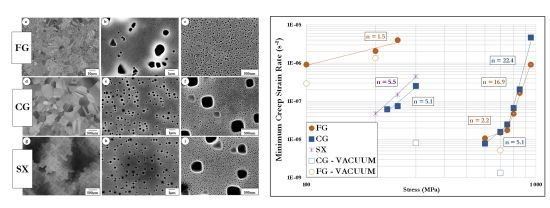Relationships between Microstructural Parameters and Time-Dependent Mechanical Properties of a New Nickel-Based Superalloy AD730™
Abstract
:1. Introduction
2. Experimental Procedure
2.1. Material
| Element | Ni | C | Cr | Mo | W | Al | Co | Ti | Nb | Fe | B | Zr |
|---|---|---|---|---|---|---|---|---|---|---|---|---|
| Wt. % | Balance | <0.02 | 16 | 3 | 2.7 | 2.3 | 8.5 | 3.5 | 1.1 | 4 | 0.01 | 0.03 |
| Microstructure | Grain Size | Average γ’ Precipitation Size | |||
|---|---|---|---|---|---|
| Primary | Coarse Secondary | Fine Spherical Secondary | Tertiary | ||
| Fine Grains | 10 µm | 1 µm | X | 40 nm | N.O. |
| Coarse Grains | 350 µm | X | 300 nm | 35 nm | N.O. |
| Single Crystals | X | X | 300 nm | 35 nm | N.O. |
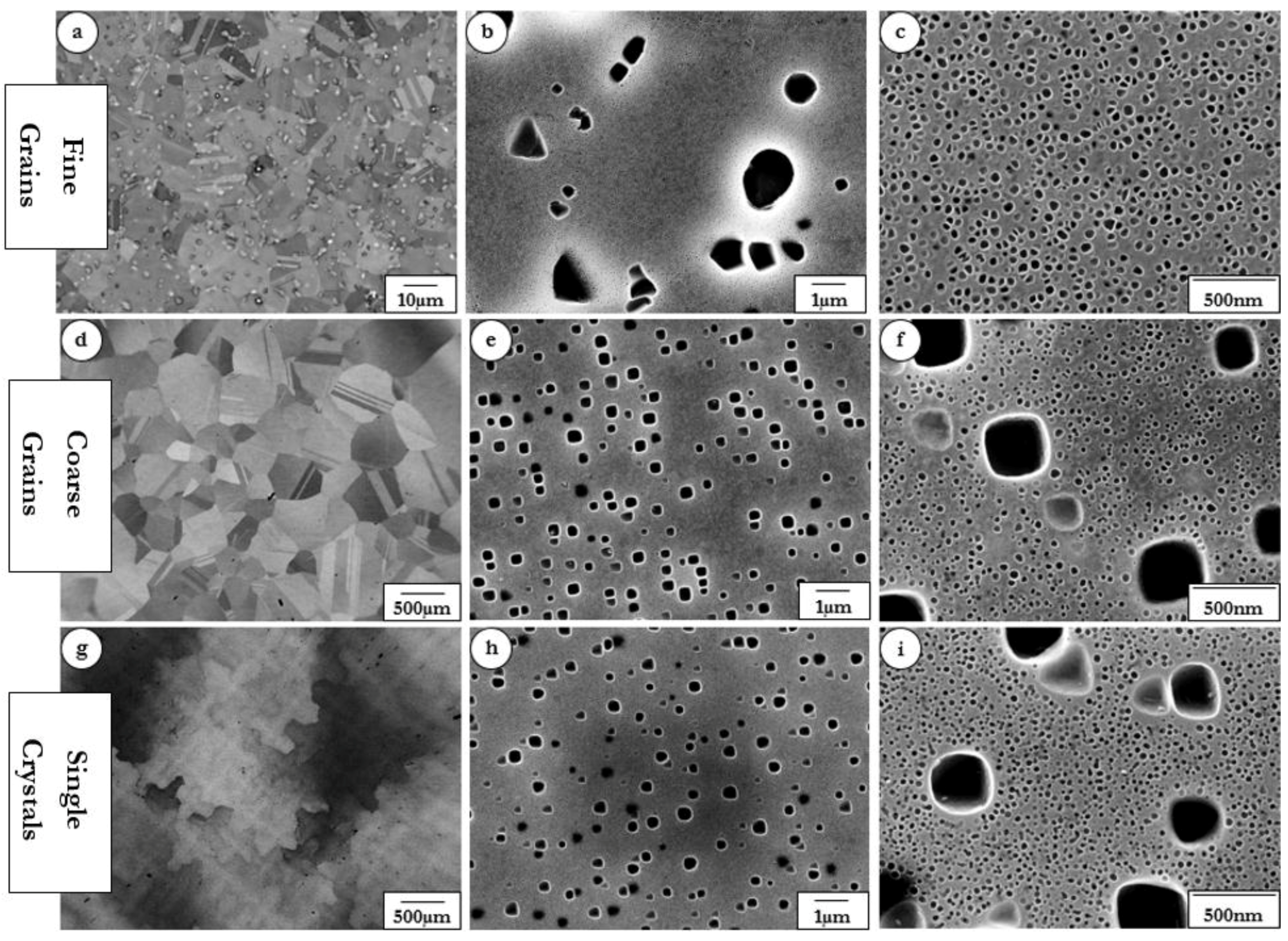
2.2. Mechanical Testing
3. Results
3.1. Creep Behavior
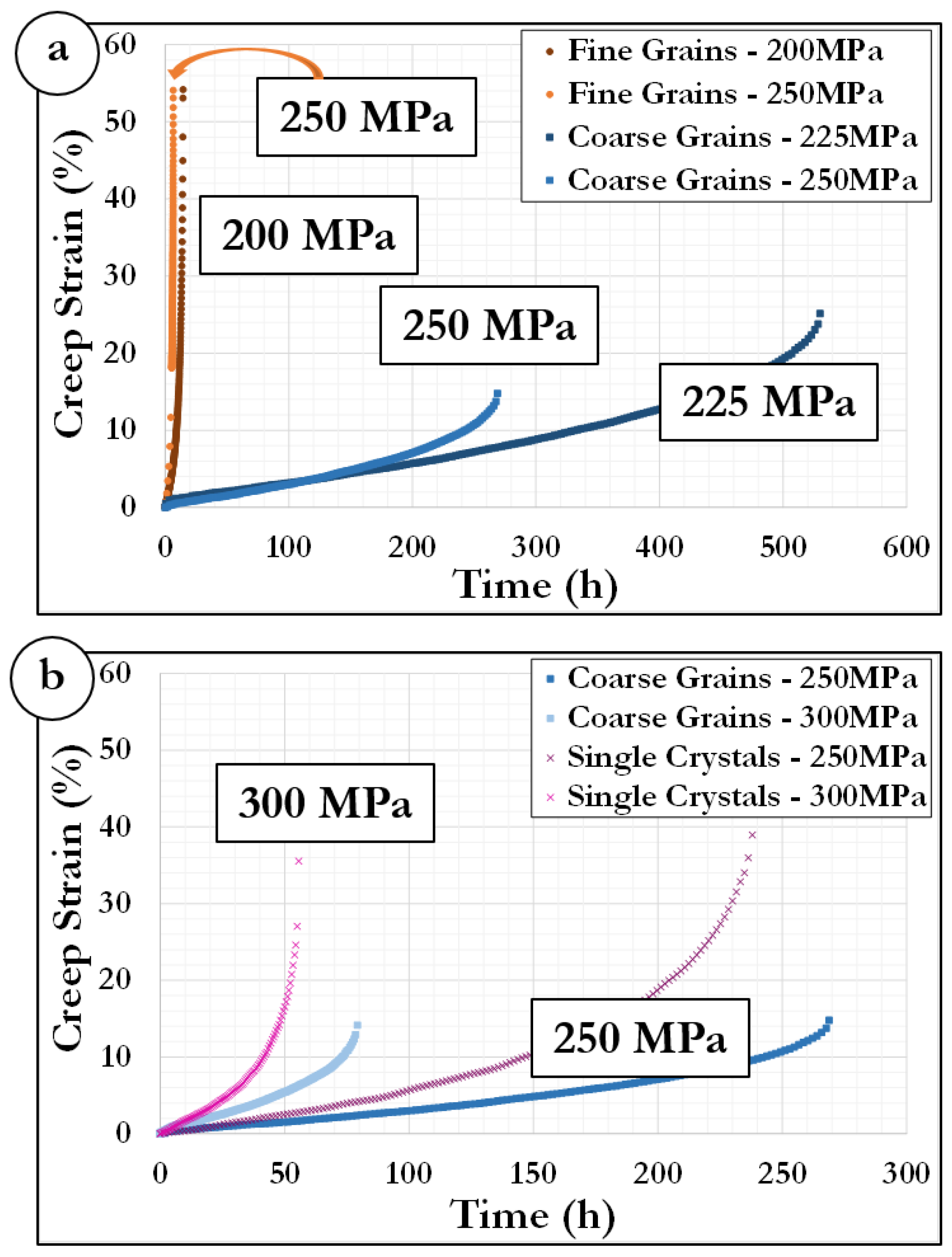

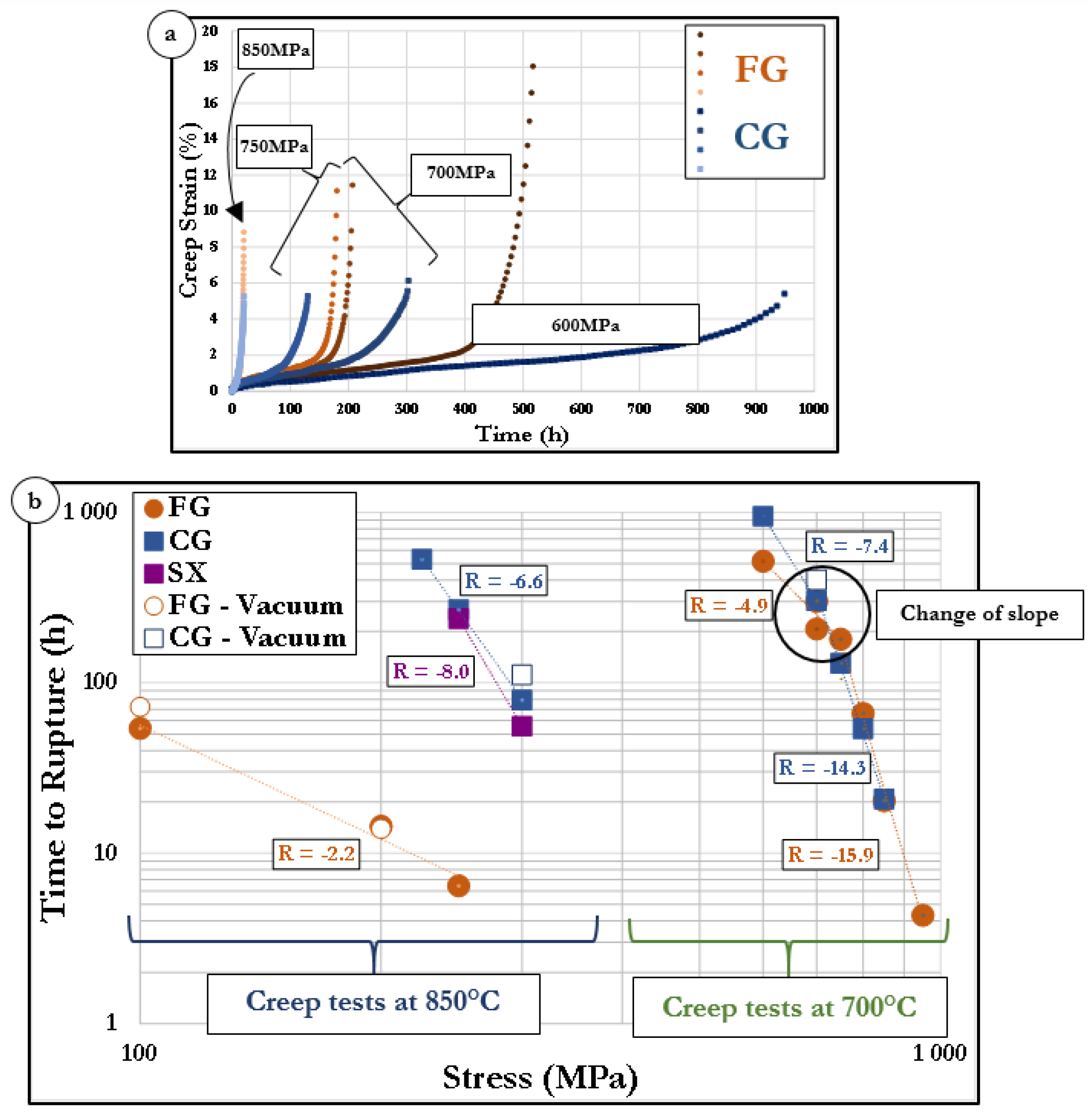
3.2. Dwell-Fatigue Behavior

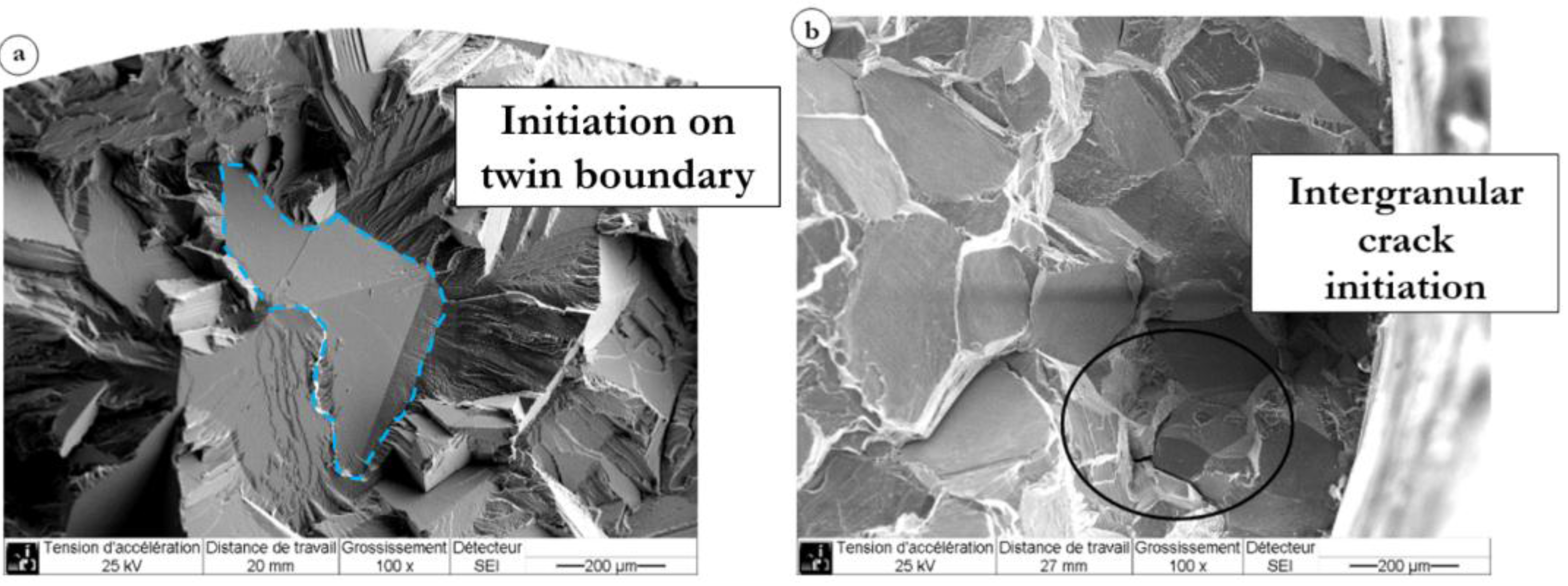
4. Discussion
4.1. Deformation and Damage Mechanisms during Creep
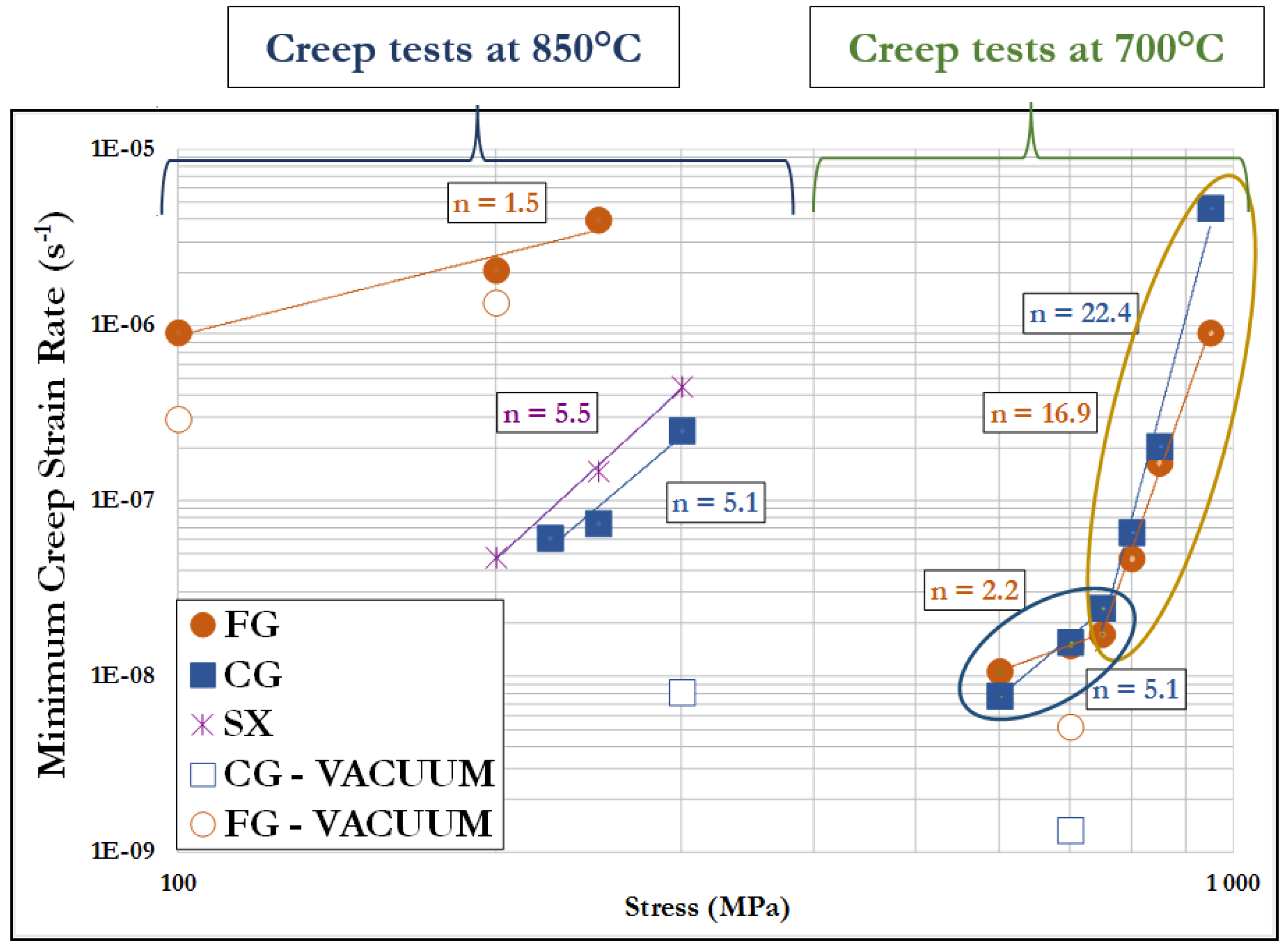
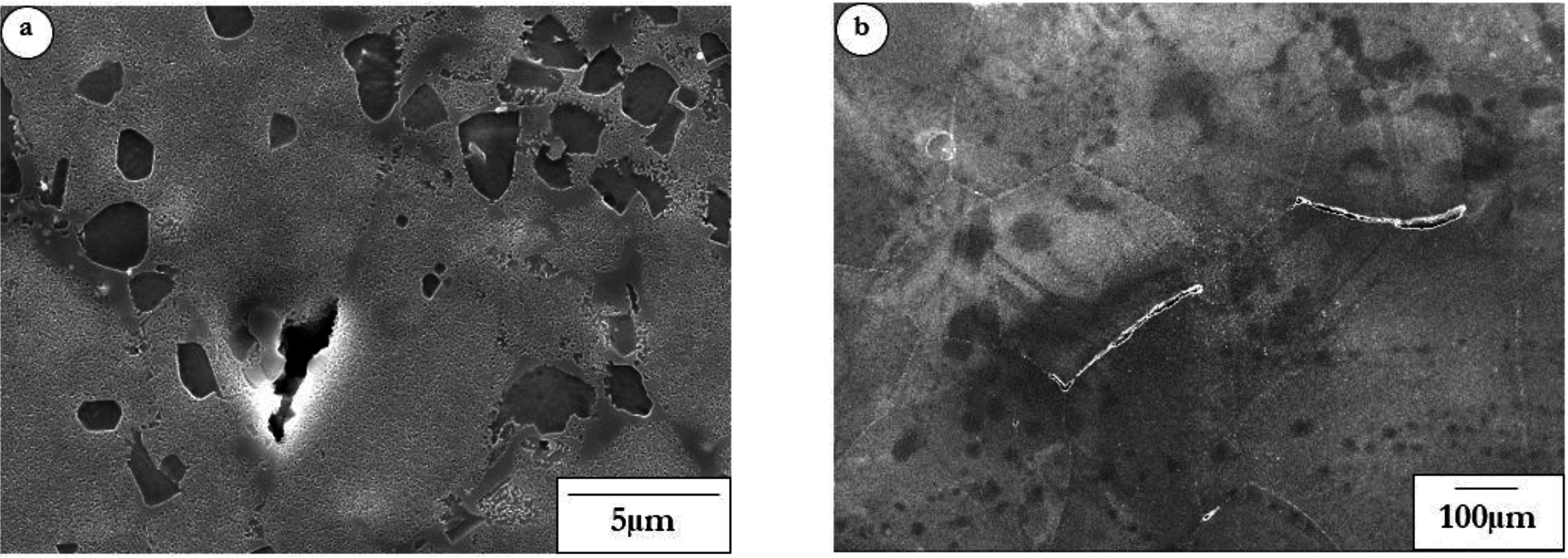
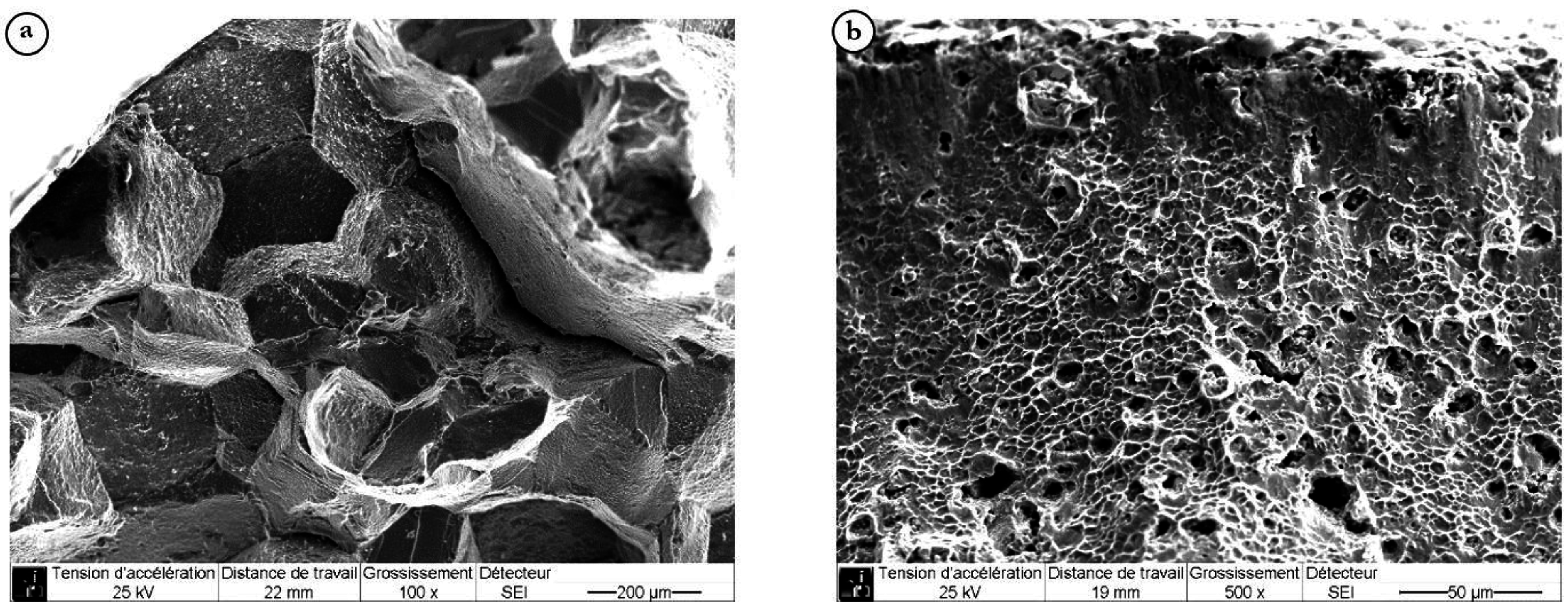
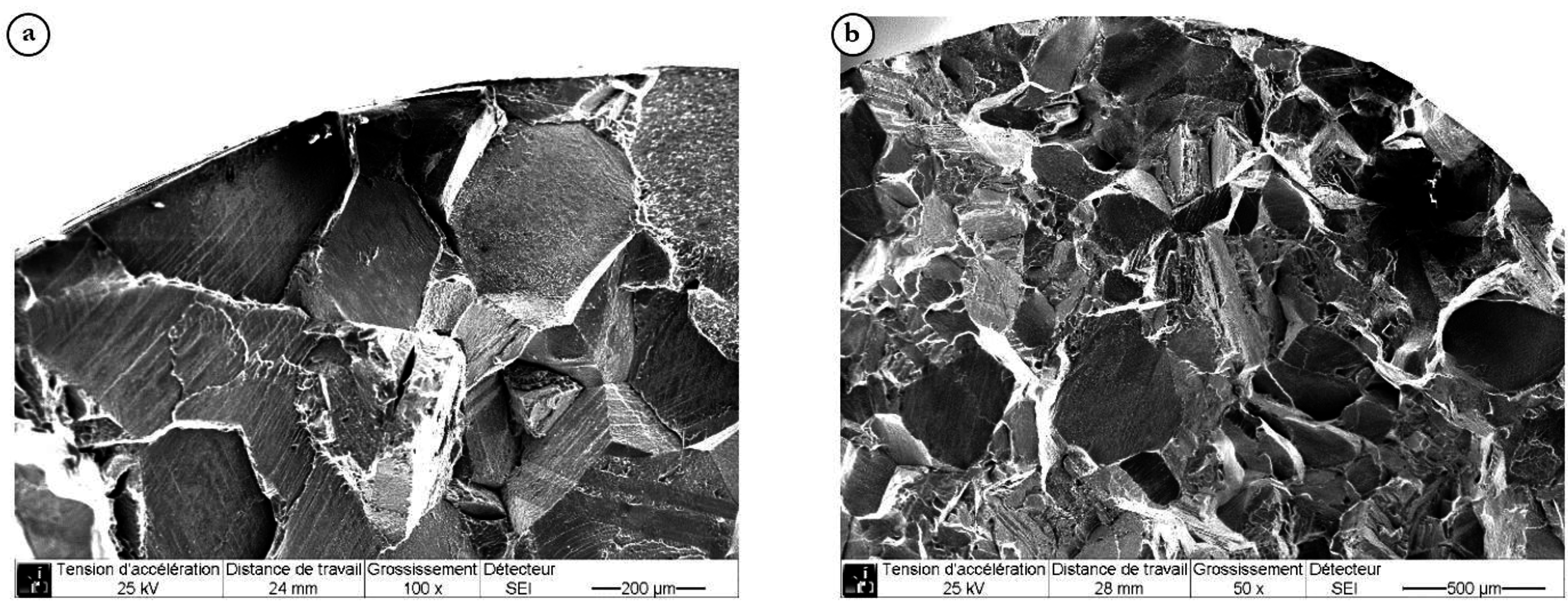
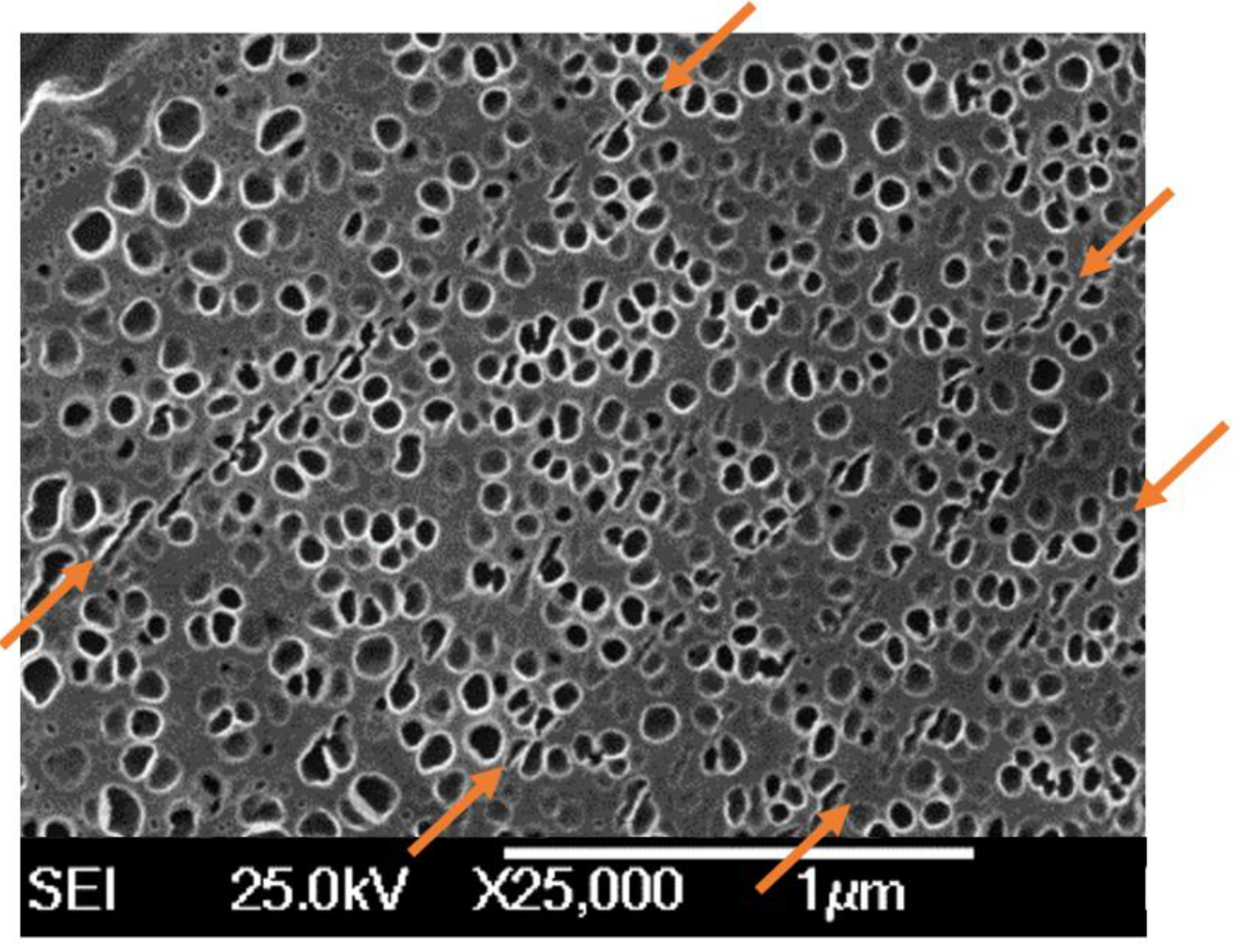
4.2. Deformation and Damage Mechanisms during Dwell-Fatigue Loading at 700 °C

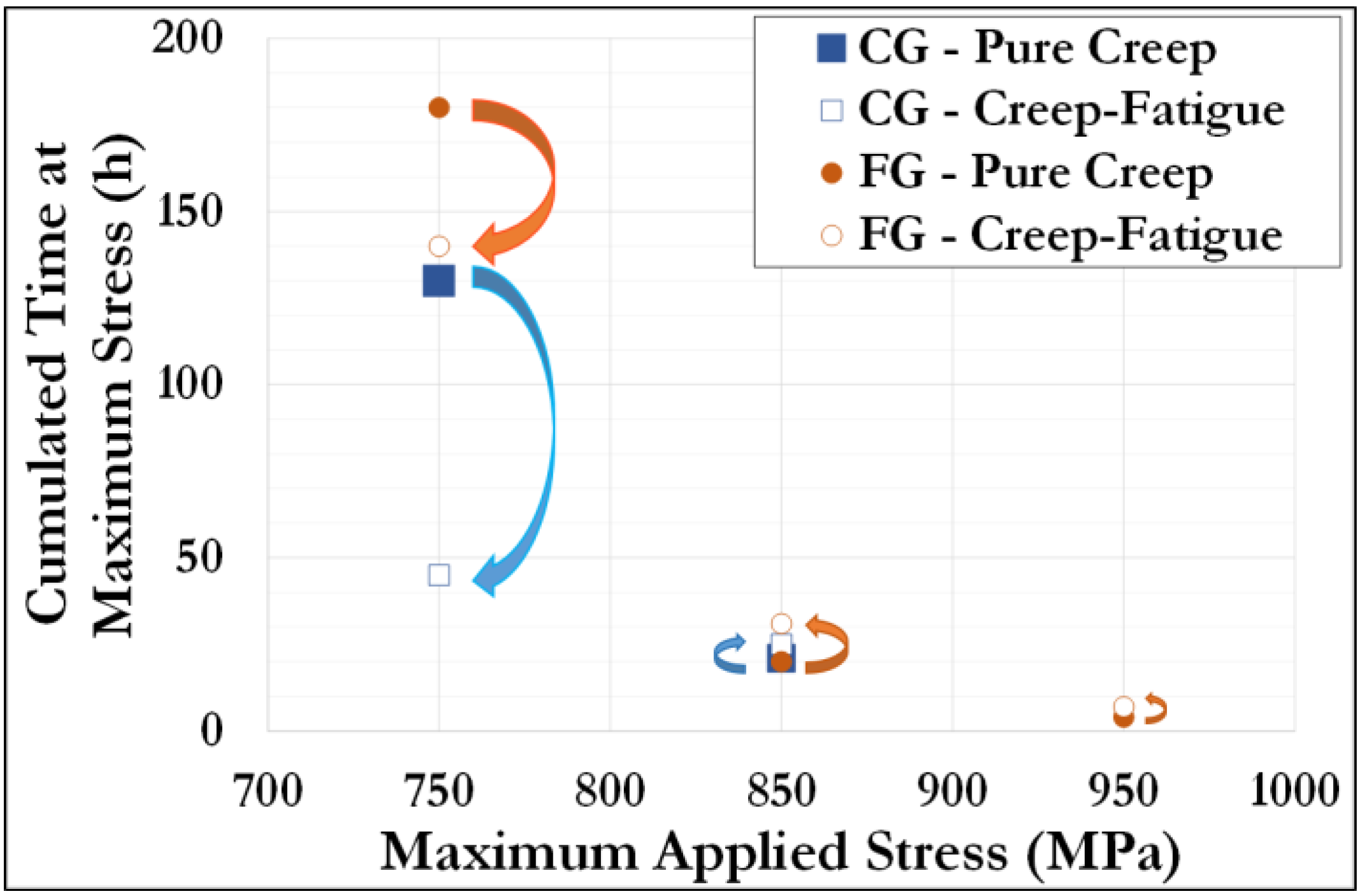
5. Conclusions
Acknowledgments
Author Contributions
Conflicts of Interest
References
- Brooks, J.W.; Bridges, P.J. Metallurgical Stability of Inconel 718. In Superalloys 1988; TMS: Warrendale, PA, USA, 1988; pp. 33–42. [Google Scholar]
- Devaux, A.; Nazé, L.; Molins, R.; Pineau, A.; Organista, A.; Guédou, J.Y.; Uginet, J.F.; Héritier, P. Gamma double prime precipitation kinetic in Alloy 718. Mater. Sci. Eng. A 2008, 486, 117–122. [Google Scholar] [CrossRef]
- Devaux, A.; Georges, E.; Héritier, P. Properties of New C&W Superalloys for High Temperature Disk Applications. In Proceedings of the 7th International Symposium on Superalloy 718 and Derivatives, Pittsburgh, PA, USA, 10–13 October 2010; TMS: Warrendale, PA, USA, 2010; pp. 223–235. [Google Scholar]
- Devaux, A.; Georges, E.; Héritier, P. Development of New C & W Superalloys for High Temperature Disk Applications. Adv. Mater. Res. 2011, 278, 405–410. [Google Scholar]
- Devaux, A.; Picqué, B.; Gervais, M.; Georges, E.; Poulain, T.; Héritier, P. AD730™—A New Nickel-Based Superalloy for High Temperature Engine Rotative Parts. In Superalloys 2012; TMS: Warrendale, PA, USA, 2012; pp. 911–919. [Google Scholar]
- Devaux, A.; Helstroffer, A.; Cormier, J.; Villechaise, P. Effect of Aging Heat-Treatment on Mechanical Properties of AD730™ Superalloy. In Proceedings of the 8th International Symposium on Superalloy 718 and Derivatives, Pittsburgh, PA, USA, 28 September–1 October 2014; TMS: Warrendale, PA, USA, 2014; pp. 521–535. [Google Scholar]
- Flageolet, B. Effet du Vieillissement du Superalliage Base Nickel N18 Pour Disques de Turbines sur sa Durabilité en Fatigue et en Fatigue-Fluage à 700 °C. Ph.D. Thesis, École Nationale Supérieure de Mécanique et d’Aérotechnique, Chasseneuil-du-Poitou, France, 2005. [Google Scholar]
- Miner, R.; Gayda, J.; Maier, R. Fatigue and creep-fatigue deformation of several nickel-base superalloys at 650 °C. Metall. Trans. A 1982, 13, 1755–1765. [Google Scholar] [CrossRef]
- Zrnık, J.; Semenak, J.; Vrchovinsky, V.; Wangyao, P. Influence of hold period on creep—Fatigue deformation behaviour of nickel base superalloy. Mater. Sci. Eng. A 2001, 319, 637–642. [Google Scholar] [CrossRef]
- Billot, T. Comportement et endommagement en fatigue et fatigue-fluage à haute température de différents états microstructuraux du superalliage base-nickel Udimet 720. Ph.D. Thesis, École Nationale Supérieure de Mécanique et d’Aérotechnique, Chasseneuil-du-Poitou, France, 2010. [Google Scholar]
- Reed, R.C. The Superalloys: Fundamentals and Applications; Cambridge University Press: Cambridge, UK, 2006. [Google Scholar]
- Billot, T.; Villechaise, P.; Jouiad, M.; Mendez, J. Creep-fatigue behavior at high temperature of a UDIMET 720 nickel-base superalloy. Int. J. Fatigue 2010, 32, 824–829. [Google Scholar] [CrossRef]
- Laurence, A. Impact du sur-vieillissement métallurgique sur le comportement et la durabilité du superalliage base nickel René 65. Ph.D. Thesis, École Nationale Supérieure de Mécanique et d’Aérotechnique, Chasseneuil-du-Poitou, France, 2016. [Google Scholar]
- Nabarro, F.; de Villiers, H. The Physics of Creep; Taylor & Francis: London, UK, 1995. [Google Scholar]
- Laurence, A.; Cormier, J.; Villechaise, P.; Billot, T.; Petinari-sturmel, F.; Hantcherli, M.; Mompiou, F. Impact of the solution cooling rate and of thermal aging on the creep properties of the new cast&wrought René 65 Ni-based superalloy. In Proceedings of the 8th International Symposium on Superalloy 718 and Derivatives, Pittsburgh, PA, USA, 28 September–1 October 2014; TMS: Warrendale, PA, USA, 2014; pp. 333–348. [Google Scholar]
- Locq, D.; Caron, P.; Raujol, S.; Pettinari-Sturmel, F.; Coujou, A.; Clément, N. On the Role of Tertiary γ’ Precipitates in the Creep Behaviour at 700 °C of a PM Disk Superalloy. In Superalloys 2004; Green, K.A., Pollock, T.M., Harada, H., Eds.; TMS: Warrendale, PA, USA, 2004; pp. 179–187. [Google Scholar]
- Soula, A. Etude de la Déformation Intergranulaire au Cours du Fluage à Haute Température d’un Superalliage à Base de Nickel Polycristallin. Ph.D. Thesis, Institut National Polytechnique de Grenoble, Grenoble, France, 2010. [Google Scholar]
- Shewfelt, R.; Brown, L. High-temperature strength of dispersion- hardened single crystals : I. Experimental results. Philos. Mag. 1974, 30, 1135–1145. [Google Scholar] [CrossRef]
- McLean, M. On the threshold stress for dislocation creep in particle strengthened alloys. Acta Metall. 1985, 33, 545–556. [Google Scholar] [CrossRef]
- Arzt, E.; Wilkinson, D.S. Threshold stresses for dislocation climb over hard particles: The effect of an attractive interaction. Acta Metall. 1986, 34, 1893–1898. [Google Scholar] [CrossRef]
- Sinha, N.K. Short strain relaxation/recovery tests for evaluating creep response of nickel-base superalloys like IN-738LC. J. Mater. Sci. Lett. 2001, 20, 951–953. [Google Scholar] [CrossRef]
© 2015 by the authors; licensee MDPI, Basel, Switzerland. This article is an open access article distributed under the terms and conditions of the Creative Commons Attribution license (http://creativecommons.org/licenses/by/4.0/).
Share and Cite
Thébaud, L.; Villechaise, P.; Cormier, J.; Crozet, C.; Devaux, A.; Béchet, D.; Franchet, J.-M.; Organista, A.; Hamon, F. Relationships between Microstructural Parameters and Time-Dependent Mechanical Properties of a New Nickel-Based Superalloy AD730™. Metals 2015, 5, 2236-2251. https://doi.org/10.3390/met5042236
Thébaud L, Villechaise P, Cormier J, Crozet C, Devaux A, Béchet D, Franchet J-M, Organista A, Hamon F. Relationships between Microstructural Parameters and Time-Dependent Mechanical Properties of a New Nickel-Based Superalloy AD730™. Metals. 2015; 5(4):2236-2251. https://doi.org/10.3390/met5042236
Chicago/Turabian StyleThébaud, Louis, Patrick Villechaise, Jonathan Cormier, Coraline Crozet, Alexandre Devaux, Denis Béchet, Jean-Michel Franchet, Antoine Organista, and Florence Hamon. 2015. "Relationships between Microstructural Parameters and Time-Dependent Mechanical Properties of a New Nickel-Based Superalloy AD730™" Metals 5, no. 4: 2236-2251. https://doi.org/10.3390/met5042236





